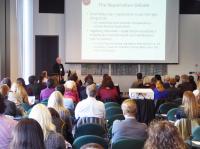Over 70 people attended the IPinCH DNA and Indigeneity public symposium held last week in Vancouver. The symposium focused on current and prospective applications of genomics in archaeology and anthropology.
The public event was followed by a two-day invited workshop that brought together an international group of academics, practitioners, students, and community representatives from Canada, the United States, Australia, and Latin America.
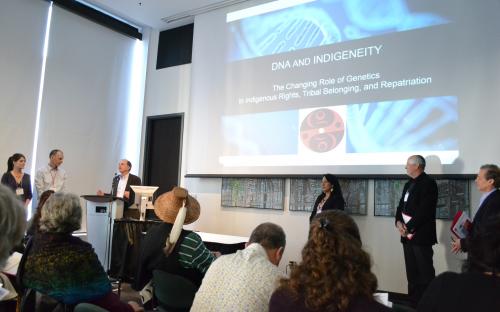
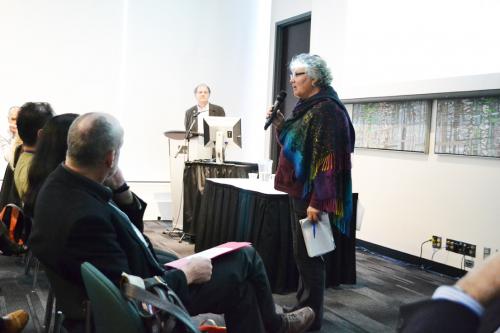
Above, IPinCH Director, George Nicholas, introduces the event planning committee (from left to right): Alexa Walker, Brian Egan, Dorothy Lippert, Daryl Pullman, and Alan Goodman. At right, audience member Vicki Kelly asks a question during the symposium Q & A period (photos: K. Brown).
The symposium began with a traditional welcome by Musqueam Nation member, Victor Guerin, followed by an introduction to the event by IPinCH Director George Nicholas.
The first session focused on the promise and perils of using genomics in constructing and interpreting Indigenous identities and featured presentations from Armand Minthorn, a religious leader and member of the Board of Trustees of the Confederated Tribes of the Umatilla Indian Reservation, Deborah Bolnick, Associate Professor at University of Texas at Austin, and Alan Goodman, Professor of Biological Anthropology at Hampshire College.
The second session explored the potential for genetic information to assist with the repatriation of human remains. This session included talks by Daryl Pullman, Professor of Medical Ethics at Memorial University of Newfoundland, Dorothy Lippert from the Repatriation Office at the Smithsonian Institution, and Cressida Fforde, Deputy Director of the National Centre for Indigenous Studies at the Australian National University.
The final session examined the problematic history of genetic research with Indigenous peoples before turning to the present to identify opportunities to work together “in a good way.” Kim TallBear, Associate Professor at the University of Alberta, Rosalina James, Assistant Professor at the University of Washington, and Ripan Malhi, Associate Professor at the University of Illinois at Urbana-Champaign, all provided their insight and experiences on this topic.
Videos of the symposium presentations will be available on the IPinCH website in the near future.
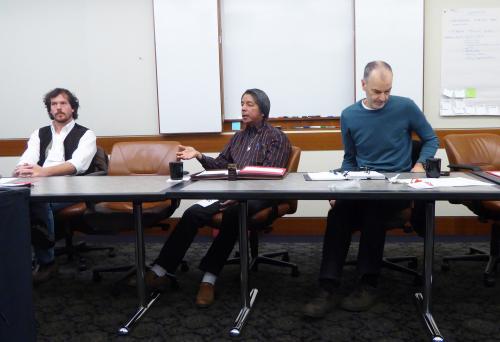
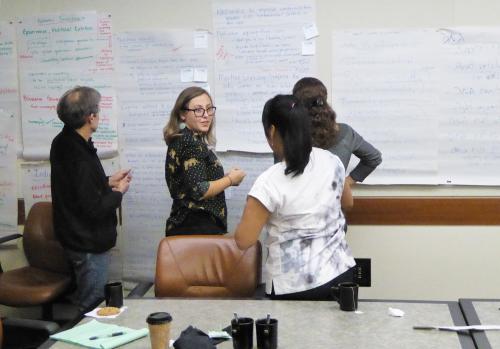
Above, David Schaepe, Armand Minthorn, and Brian Egan participate in discussions during the two-day workshop from October 23-24 at the SFU Centre for Dialogue. At right, workshop participants Alan Goodman, Sara Juengst, Deborah Bolnick, and Dorothy Lippert brainstorm and discuss outcomes from the workshop (Photos courtesy G. Nicholas).
The following two-day invited workshop was an opportunity for nineteen scholars, practitioners, and community representatives to delve further into the complex issues introduced in the symposium.
One key take away message from the workshop was the need to support Indigenous peoples and other vulnerable populations around the world in their effort to secure genetic autonomy. Genetic autonomy was described by the workshop participants as the ability to control when, where, how, and by whom the genetic information of Indigenous peoples is used. To this end, it is critical that additional resources and support are provided for Indigenous peoples seeking training in genomic sciences.
Another key point of discussion at the workshop focused on clarifying misconceptions about DNA and genetic testing. In the case of the growing use of parentage testing by Native American tribes to inform enrollment decisions, for example, there is uncertainty among many tribal members about the exact purpose of these tests and how they’re different from genetic ancestry tests. This is a cause for concern and highlights the need for more clarity on what genetic testing is and what it can (or can’t) do.
Finally, there was a strong consensus among workshop participants on the need to contextualize the results of genetic research—that is, to situate genetic data within a broader cultural, historical, and political context—particularly when working with Indigenous communities. By presenting genetic information alongside other ways of interpreting the past, such as oral histories and archaeology, we ensure a more holistic, complete, and dynamic interpretation of identities—past and present.
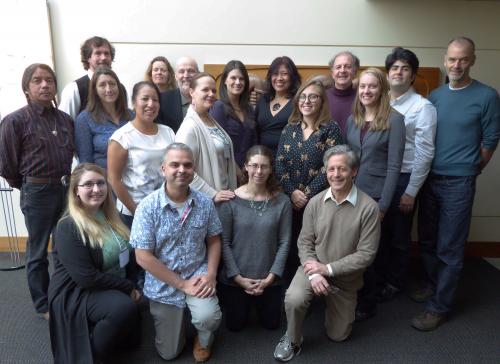
A group shot to close out the last day of the workshop on October 24 (from top left): David Schaepe, Cressida Fforde, Daryl Pullman, Alexa Walker, Kim TallBear, George Nicholas, Ernesto Schwartz-Marin, Brian Egan, Armand Minthorn, Rosalina James, Dorothy Lippert, Jessica Bardill, Sara Juengst, Teresa Nichols, Chelsea Meloche, Ripan Malhi, Deborah Bolnick, Alan Goodman (not pictured: Susan Rowley. Photo courtesy G. Nicholas).
Ultimately, genetics and ancient DNA analysis should be considered alongside other ways of understanding the identity of ancient and modern-day people. It should not take precedence but rather, in many cases, should be considered “a last resort” when all other information has been considered. For example, if there is no information on the geographic provenance or cultural affiliation of human remains, DNA analysis may provide insight into genetic relatedness at a general level.
Proposed outputs arising from the workshop include journal articles, a collection of ancient DNA case studies, a tool kit for communities considering genetic research, a travelling exhibit on DNA and Indigeneity for schools and museums, and a website housing a diverse assortment of resources.
Financial support for the event was provided by the Social Sciences and Humanities Research Council (SSHRC) and by Simon Fraser University.
Top photo: Daryl Pullman presents to the symposium crowd on October 22 at SFU Harbour Centre (Photo: G. Nicholas).


